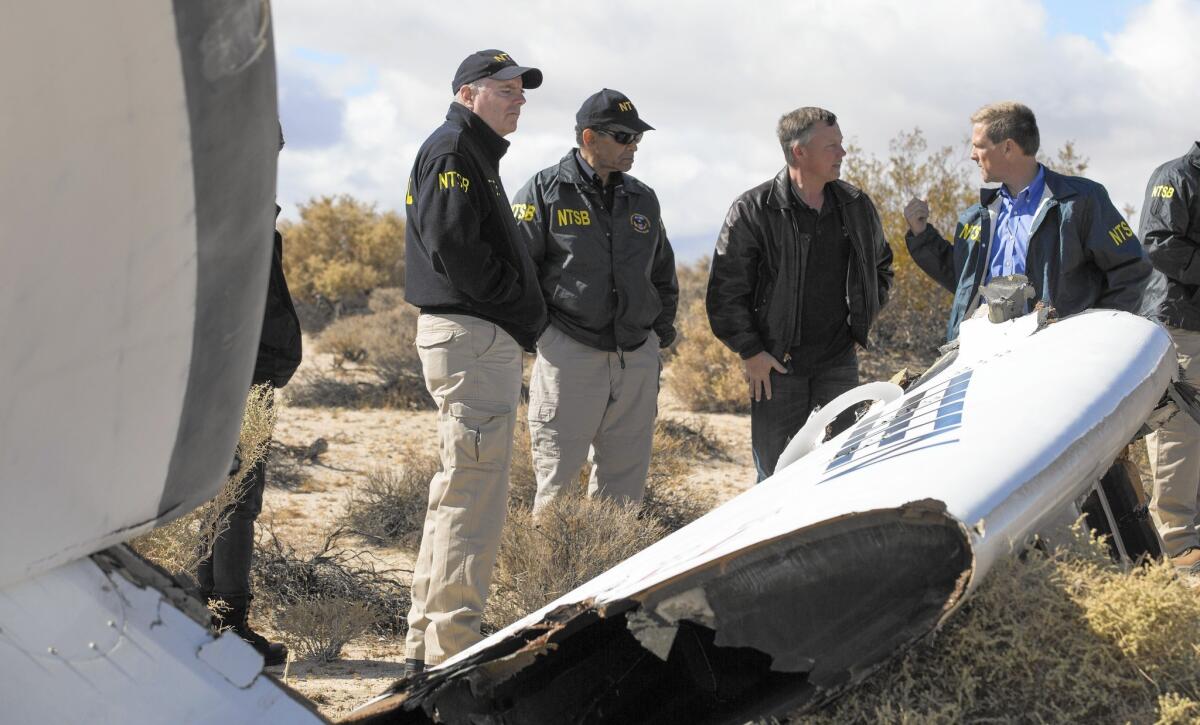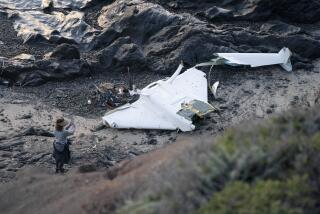Investigators scrutinize pilot actions in Virgin Galactic crash

The National Transportation Safety Board appears to be taking a much closer look at the potential for pilot error as the cause of the fatal crash of a Virgin Galactic spacecraft.
The agency’s acting chairman, Christopher Hart, said Monday night that a “human performance group” has been formed to study the interaction between the pilots and the spacecraft, including cockpit displays and checklists that pilots use to perform tasks.
After some confusion, Hart also clarified that copilot Michael Alsbury, 39, who died in the crash, prematurely flipped a switch that unlocked an aerodynamic control lever that may have played a role in Friday’s accident.
The experimental rocket plane broke up over the Mojave Desert moments after that action. Pilot Peter Siebold, 43, parachuted out of the aircraft and suffered serious injuries. Investigators have not yet been able to interview Siebold, who is in Antelope Valley Hospital after surgery for a serious shoulder injury.
The investigators are wrapping up their probe of the scene in the desert scrub brush where SpaceShipTwo, owned by British billionaire Richard Branson’s Virgin Galactic, fell in pieces. The crash dealt a serious blow to the company that has already faced years of delays in its quest of carrying tourists to space.
Parts of the experimental rocket plane were found as far as 35 miles northeast of crash site, Hart said.
It may take up to a year for the agency to complete its investigation.
NTSB investigators have determined that a key part of the spacecraft’s aerodynamic control system malfunctioned about 13 seconds after the hybrid solid rocket motor ignited in Friday’s test flight.
The SpaceShipTwo is designed to blast to the edge of Earth’s atmosphere, about 60 miles high, where the engines burn out.
Then the craft is supposed to begin a gradual descent back down, slowed by two innovative structures known as feathers. On the way up, the feathers look like long tails of a regular aircraft. But on the way down they fold up perpendicular to the line of flight and create tremendous aerodynamic drag that slows the craft.
The company calls the system’s action “feathering” because it was modeled on the birdie or shuttlecock used in badminton, which is aerodynamically stable because of the way it resists air.
On Sunday night, Hart said the NTSB had footage from a camera inside the cockpit that showed that Alsbury had prematurely moved a lever that unlocked the feathering system.
Even though the pilots did not move the second lever to deploy the feathers, Hart said, the feathers deployed anyway.
Three seconds later, the camera and other data stopped, the investigators said, indicating that the plane had been torn apart.
It remains unclear why the feathers deployed even without the pilots’ taking the second step.
It also is unclear whether the copilot made an error in unlocking the feathers or whether the crew was instead responding to a problem that they thought might be solved by deploying the feathers.
Hart said that until the point at which the feathers deployed, the test flight was going normally, including the operation of the engine.
Hart cautioned repeatedly Sunday that pilot error was just one possibility that investigators were considering and that there were still many questions.
On Monday morning, Branson appeared on three television networks, vowing to continue with his quest to take tourists to space.
In the interviews that he did from the British Virgin Islands, Branson tried to stem what had been growing criticism in recent days by experts and others who said SpaceShipTwo had multiple design flaws that made it unsafe. To do that, he focused on the NTSB’s discovery that Alsbury had prematurely moved the lever.
“I haven’t seen the video myself,” Branson told NBC’s Matt Lauer. “If the deployment did take place early, obviously they are indicating that may well be the cause.”
“If that ends up to be the case,” he added, “that is something that is easy to fix and we can be absolutely certain that it can’t be done in the future.”
“Yes, it’s been a horrible setback, in particular for Mike Alsbury’s family, and for Mike himself,” he said, “but we owe it to him to continue.”
Friday’s crash of SpaceShipTwo was the second catastrophe in a week for the commercial space industry.
Three days before, an unmanned cargo rocket headed for the International Space Station exploded just moments after liftoff from a Virginia launch pad. The $200-million rocket, owned by Orbital Sciences, was carrying 5,000 pounds of food, supplies and experiments under a contract with NASA. No one was injured in that crash.
twitter: @melodypetersen @rvartabedian








